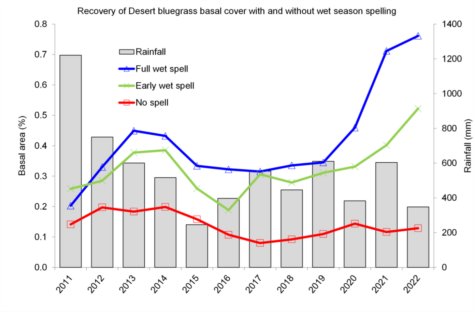Importantly, results from the Wambiana trial and elsewhere show stocking rate is just as important as (if not more important than) spelling in determining pasture condition. There will be little, if any, benefit from spelling if stocking rates are too high. Higher
stocking rates will damage pasture condition even if wet season spelling is applied.
The Wambiana trial has also shown that incorporating regular spelling increases liveweight gains in the longer term.
How to implement wet season spelling
Selecting paddocks to spell
Decide which paddock(s) you are going to spell well before the wet season. Consider:
- the current pasture condition
- when the paddock was last spelled.
Removal of animals
Animals should be removed at the end of the dry season or when convenient with musters.
Try to ensure the paddocks to be spelled have good ground cover at the end of the dry (50% is the minimum recommended level) to maximise rainfall infiltration.
Remember to consider where these animals will be moved to. Do not overgraze a paddock just to give another a wet season spell.
At the latest, paddocks should be locked up once conditions allow pasture growth (e.g. after about 50 mm of rain has fallen over 2 days). Local long-term rainfall data can help you predict when this might be in your region. For example, Charters Towers usually has 50 mm fall in two days by 28 January.
How long should you spell for?
At a minimum, paddocks should be spelled for the first 6 to 8 weeks of the wet season, when plants are most sensitive to grazing. However, a full wet season spell will give the greatest benefit, as the late growing season is when grasses store reserves to drive growth for the next year. If paddocks are in poor condition, a full wet season spell may be required for several years.
Closely monitor unspelled, grazed paddocks throughout the wet season for over utilisation. If this happens it is best to open up spelled areas or sell cattle to reduce pressure on grazed paddocks.
In a very dry year when forage is scarce it might be best not to spell to avoid over-grazing other paddocks.
Remember, if you have had a failed wet season, the paddock has not had a wet season spell.
Wet season spelling aftercare
Once the desirable 3P species have set seed, cattle can be reintroduced to the paddock.
However, ensure stocking rates match the amount of feed present. This can be determined using a forage budget to ensure sufficient residue remains at the end of the dry season.


